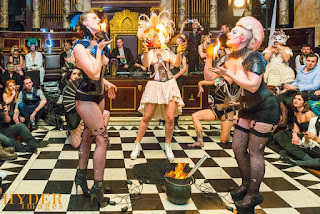Thought for the day:"Noses run in my family."
The Andaz itself is an impressive mixture of Victorian craftsmanship and modern interiors. The hotel, originally the Great Eastern, was built by Charles Barry Jnr, son of the architect of the Houses of Parliament. Barry also crafted the temple, at a cost of some £50,000 (around £4 million in today's reckoning). The room reportedly contains 12 types of marble, as well as a golden pipe organ and mahogany furniture.
Today the room is used as an events venue. If you don't move in circles swanky enough to be invited along to such things, you can normally get a peek inside the temple on Open House weekends every September.
Built adjacent to London’s Liverpool Street train station in 1884, the Great Eastern Hotel was one of the city’s original railway hotels. Usually impressive in size, these buildings were designed as a symbolic demonstration of rail transport’s wealth. The luxurious hotel enjoyed the swanky privilege of owning its own track inside the train station for daily provisions delivery, including sea water for the hotel’s salt water baths.
However, when the tourism industry boomed, hotels of all sizes sprang up across the city and cars gradually replaced trains as the primary mode of transport. Sadly, the Great Eastern soon fell behind the times and languished as a dusty old mansion. However, almost a century after its opening, the Great Eastern Hotel found a new destiny through designer Terence Conrad, who decided to polish the landmark by getting rid of the outdated interiors and giving the building an ambitiously chic makeover. However, during the restoration, engineers are said to have noticed a few discrepancies in the blueprints. Then, like something out of an adventure movie, they removed one of the walls to find a wood-paneled antechamber and, on the other side of a studded double door, a vast and incredibly refined masonic temple.
Built in 1912, this forgotten chamber is a pure jewel of luxury, and probably one of the most grandiose Masonic temples in London. Neoclassic in style, the windowless room is known as the “Grecian Temple.” The opulent room includes an organ, hand-carved mahogany chairs, bronze candelabras on claw feet, and no less than 12 different types of marble used in the floor, columns, and walls. The celling, a blue and gold dome, bears a five-pointed “blazed star” and zodiac signs. The room conforms to the classic Masonic temple setting with a checkerboard floor and discreet esoteric insignias.
Today the hotel is part of the Hyatt Hotel Group, and the Great Eastern Hotel is known as the Andaz. The Grecian Masonic Temple is still there and open upon reservation.












































No comments:
Post a Comment